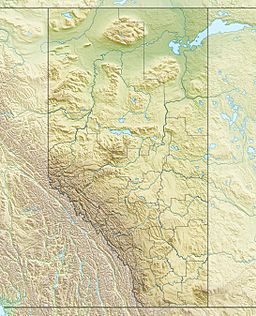Blood Indian Creek Reservoir facts for kids
Quick facts for kids Blood Indian Creek Reservoir |
|
|---|---|
| Location | Special Area No. 3, Alberta |
| Coordinates | 51°15′00″N 111°12′30″W / 51.25000°N 111.20833°W |
| Basin countries | |
| Built | 1965 |
| Max. length | 3.3 km (2.1 mi) |
| Max. width | 0.6 km (0.37 mi) |
| Surface area | 1.03 km2 (0.40 sq mi) |
| Average depth | 4.6 m (15 ft) |
| Max. depth | 13.3 m (44 ft) |
| Surface elevation | 760 m (2,490 ft) |
| Settlements | Big Stone |
The Blood Indian Creek Reservoir is a special kind of lake in Alberta, Canada. It is not a natural lake. Instead, it is a human-made lake called a reservoir.
This reservoir is located in a place called Special Area No. 3. The small community of Big Stone is found right on its northern edge.
Contents
What is Blood Indian Creek Reservoir?
A reservoir is like a giant storage tank for water. People build them by putting a dam across a river or stream. This creates a large area where water can collect.
Reservoirs are very important. They help us store water for many uses. This includes drinking water, watering crops, and even making electricity.
Where is it located?
Blood Indian Creek Reservoir is in the province of Alberta. Alberta is one of Canada's western provinces.
It is specifically located in a rural area known as Special Area No. 3. This area is mostly used for farming and ranching.
The hamlet of Big Stone sits right next to the reservoir. It is a small community in this part of Alberta.
How big is it?
The Blood Indian Creek Reservoir is quite large. It stretches about 3.3 kilometers (2 miles) long.
It is also about 0.6 kilometers (0.4 miles) wide. The total surface area of the water is about 1.03 square kilometers (0.4 square miles).
The water in the reservoir is about 4.6 meters (15 feet) deep on average. At its deepest point, it can reach about 13.3 meters (44 feet).
The reservoir sits at an elevation of about 760 meters (2,493 feet) above sea level. This means it is quite high up.
Why was it built?
The Blood Indian Creek Reservoir was built in 1965. It was created to help manage water resources in the area.
Reservoirs like this one are often built for several reasons. They can store water for irrigation, which helps farmers grow crops.
They also help control floods by holding back excess water during heavy rains. This protects communities downstream.
Sometimes, reservoirs are also used for recreation. People might go fishing or boating there. However, the main purpose is usually water management.


